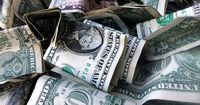On April 7, 2025, the US dollar exchange rate surged beyond 86 rubles for the first time since March 13, 2025, as trading data revealed significant fluctuations in currency values. At 9:00 AM Moscow time, the dollar was valued at 84.3981 rubles. However, just 45 minutes later, the dollar sharply rose to 86.0129 rubles, marking a notable increase.
By 11:36 AM Moscow time, the dollar strengthened even further, reaching 86.3004 rubles, an increase of almost 2 rubles since the morning. This level of trading had not been seen since mid-March, indicating a potential shift in market dynamics.
In addition to the dollar's rise, the Chinese yuan also experienced an increase, reaching 11.79 rubles. This was reflected in the "tomorrow" exchange rate for the yuan, which saw a rise of 7 kopecks at 10:03 AM Moscow time.
The fluctuations in currency values are attributed to ongoing trade tensions, particularly following the introduction of tariffs by former US President Donald Trump against various countries. These economic pressures have impacted the Russian stock market, which recently updated its minimum indicators for the year.
The dollar's rise is a significant development in the context of the current economic landscape, as it not only affects trade but also influences consumer confidence and investment strategies. Analysts are closely monitoring these changes, as the implications could extend beyond immediate currency valuation.
As the dollar continues to climb, market observers are left wondering how this will affect Russia's economy, particularly in relation to trade with the US and China. The increasing value of the dollar may lead to higher import costs, which could trickle down to consumers.
Furthermore, the rise of the yuan against the ruble may indicate a strengthening of China's economic influence in the region. This could lead to shifts in trade patterns, as businesses adapt to the changing currency landscape.
With the dollar trading at levels not seen in weeks, the Russian financial landscape is poised for potential volatility. Investors and consumers alike are urged to stay informed as the situation develops.




